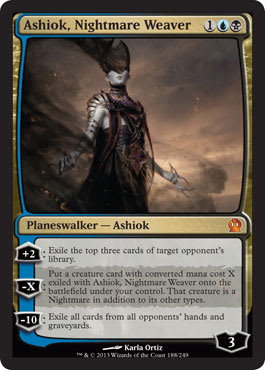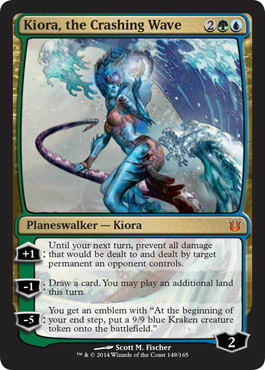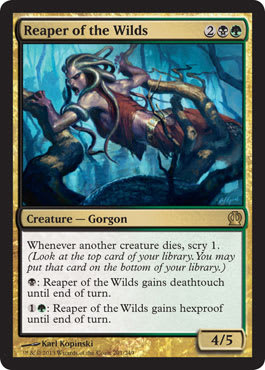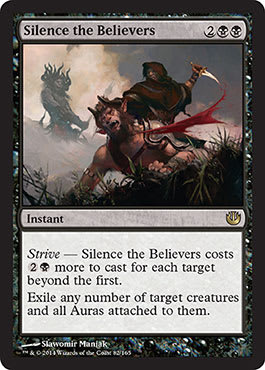This time of year heralds a number of interesting changes in Magic, and this time around, it seems no different. Magic: The Gathering—Conspiracy finally saw some widespread spoiling, and I cannot wait for the set, but I will refrain from talking too much about the financial ramifications until we have more spoilers and an idea of how limited the print run will be. This time of year also brings about the last chance to dump Standard cards before we see the gradual decline that occurs over the summer, inevitably leading into rotation in the fall. Next week, I will begin to piece apart Standard, deciding what to hold and what to move while you still can. This week, I want to jump back to a subject I discussed earlier this month: Block Constructed and what the Pro Tour this past weekend has taught us about the potential translation of Theros into the new Standard.
I was pleasantly surprised with the variation present in Atlanta this past weekend, but as expected, there were certainly some gems that seemed to be showing up in a variety of archetypes. Cards that fill niche roles within a particular environment may not always translate over to another format, so though some of the surprise players at the Pro Tour may be worth taking a look at, I tend to focus on the cards that had a major impact on the format as a whole—not just in one particular deck. I discussed a few weeks ago what I felt may be undervalued from the block, but that was based on what little knowledge was out there about this Block format, and it was certainly before any real results were posted. That article can be found here, and considering the limited information I had to go on, it seems that I overall identified a number of key players at the Pro Tour, including Reaper of the Wilds and Ashiok, Nightmare Weaver, both of which I will briefly touch on again today.
The Pro Tour taught us a few very valuable lessons about Theros block as a whole, and the most notable of these is that, so far, it seems midrange is king. Most of what we saw dominating the top tables all weekend were midrange value decks that either attempted to end the game through large plays such as Elspeth, Sun's Champion or included ways to drop an opponent low enough to finish him or her when the opponent did tap out for the big ’Walker. That being said, it is important to note just how influential Elspeth was; the fact that people were testing every deck to either race or outpace the white ’Walker shows just how much of an impact she may have in the future Standard. 6 mana may seem like a lot to invest into her, but considering how quickly she can either reset the board or take control of the game, it is no wonder people were either looking to play her or had a strong idea on how to beat here.
Currently, Elspeth is sitting right around $20, and though that is certainly a number that keeps me from wanting to buy in, I do recognize just how much influence she may have on the next Standard, and that certainly makes me comfortable trading for them or getting into them with cash if you can find a good deal. With the introduction of Temples as the primary fixing, it is much easier to consistently hit land drops in any midrange deck as long as you can survive playing a turn behind. This means that playing something like Elspeth—while you’re not required to run twenty-six or more lands—is viable, allowing her to fill roles in a multitude of decks, and that gives me even more hope than I usually would have for something with such a high mana cost.
On the topic of Planeswalkers, it is clear that Kiora, the Crashing Wave is still on people’s radars for next season, and though she is certainly proving herself more playable than many anticipated, she does have a bit of a steep entry cost currently, leaving very little room for profit down the road. Unlike Elspeth, Kiora fits into a much more narrow selection of decks, and her current price seems just about right if her play continues. That being said, she has much more potential downside, leading me to stray away from picking to many up.
Ashiok has been among my personal favorites from this block, and Ashiok certainly shined this past weekend, both milling and gumming up the board with opponent’s creatures. Unlike the other two ’Walkers, you can easily find Ashiok for just over $5 making the investment to at least pick up your personal play set relatively low. If you do not already have copies to play with, snag them now, and if you want a fairly safe card to sit on for a few months, look no further.
Straying from all of the higher-end cards, there are some other mythics and rares that fall in line with Ashiok—or that are lower in some cases—in terms of price. Some of the most-played rares in the set are almost certainly underpriced at this point. Both Sylvan Caryatid and Courser of Kruphix seem to be the focal points for the success of green-based ramp, as those cards provide efficient mana while also being relatively good walls, thus preventing aggro from really shining. We saw this time and time again all weekend as Sylvan Caryatid on 2 usually spelled disaster if it was not answered right back. This card will certainly be a player next year, and I expect Courser to follow suit. It may seem a bit high to be buying in on Courser, as it may have a ways to drop, but I would certainly snag your set if you can. The card may fall some before it spikes, but it will not be far, and it may just as easily hit $15 and never look back for the next year. Rarely do we have the ability to identify such a strong player in the format from just one event, but this Pro Tour showed us exactly what those two cards can and will do next year.
Even cheaper than these two green staples, we have a handful of cards that also saw extensive enough play to be deemed likely candidates for next year. The four that really stuck out to me were Prognostic Sphinx, Reaper of the Wilds, Hero's Downfall, and Silence the Believers. I have talked about most of these before, but it is worth noting how important each of these spells was during any match in which it was played. I never once saw one of these cards stranded or useless, and many times, the top-deck of one of these cards influenced the inevitable end of the game.
Hero's Downfall is the most expensive of this lot, but given that, it is among the more versatile and cheap removal spells ever printed—it may have a shot at real Modern play down the road, which means that if the price spikes, it may not be solely from Standard, and it can, in turn, have a higher ceiling. That being said, Reaper of the Wilds, while one of the cheapest, has also been reprinted a number of times now, and though I do expect it to rise, it may be the one I focus on the least. I expect black and green to be best friends next year, but the other cards on this list probably have more homes as well.
Prognostic Sphinx’s price baffles me. I understand that it is not playable in this current Standard, but anyone who has had the pleasure of turning that card sideways knows just how impactful it can be on the game. Built-in protection, even for the price, certainly will make this a contender come next fall, and it would take something fairly overpowered to replace this effect in my opinion. Though it’s certainly not the card many decks were built around, it fit nicely into a number of roles and always seemed to change the pace of the game when it resolved.
Silence the Believers is the last card I want to cover this week. Though there are certainly more speculative targets, this list seems to be the primary focus for me until I see more interactions within the block itself. These all translate well into a starting format, as most are mono-colored or paired with popular color combinations. Silence the Believers reminded me of Sever the Bloodline at first, as I imagine it did for most. The truth is this card is just—plain and simply put—better all around, better-positioned for the format, possessing of a more relevant effect, and, to top it off, an instant, which played very well into a more midrange- or control-oriented format. I do not suspect this card will reach the potential price of others, such as Courser, but I would not be surprised to see this hit $5 over the next year. The lack of sweepers currently available for next fall also makes this a more appealing option, as the control variants will still need ways to create two- or three-for-ones. This would normally seem far too slow to consistently create that effect, but with an early game full of reasonable bodies that also keep you hitting land drops and making mana, it begins to seem much more plausible. If nothing else, stash a few sets away, as I know you will not regret that decision when rotation comes.
Thank you, as always, for reading. I know most people do not completely understand the relevance of Block, as it sees very little play, but for a financially-well-minded person looking to minimize the expense of this game, it can be a great window into what you may need well in advance of when the cards will spike. It doesn’t hurt to at least be safe on cards as cheap as the rares I mentioned and just keep in mind the direction your current Return to Ravnica cards will be going comparatively to the Theros cards that are flying under the radar. Join me next week as I get back to the Magic theory and stray away from particular cards that I have spent the past few weeks concentrating on.
Ryan Bushard


























